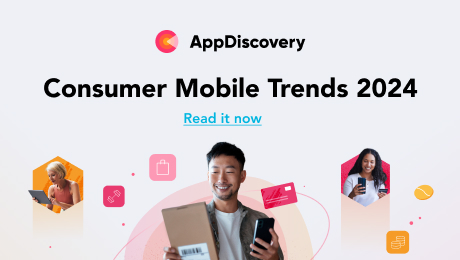According to IAB’s report, Outlook 2022: The US Digital Advertising Ecosystem, consumers are increasingly fleeing bad ad-supported media experiences. Both buy-side and sell-side marketers need to provide more contextually relevant experiences and quickly engage users with the best possible ad-supported experiences for sustained revenue growth. Mobile display and in-app advertising, therefore, need to be appropriately paced and relevant.
Consider:
- In Q4 2021, 55.4% of web traffic came from mobile devices, followed by laptops and desktops with 41% of web traffic, and tablets and other devices at about 3.5%
- Consumers spend an average of up to 4.8 hours — one-third of daily waking hours — on their devices, and 90% of that is spent in-app, eclipsing even TV viewing
Consumers spend more time than ever on mobile devices, and most of their mobile time is spent in applications — so if you want to reach as many as possible, you need to engage users on both fronts and use the strengths of each to boost the effectiveness of your campaigns.
It all “ads” up
Display ads and in-app ads share some characteristics. For example, they can both contain similar features, such as rich media, video, and other interactive elements. The key differences lie between how and where the ads are experienced on a mobile device, and how the user is targeted and reached.
Traditional display advertising – build brand awareness
The term ‘display advertising’ broadly describes what might be considered ‘traditional’ display ads that appear as part of search results or in a website.
Often, they take the form of a banner with a click-to-download, click-to-call, or even click-to-SMS for contacting an advertiser — but they can take other forms as well. Other types of display ads include native ads, which are placed on a website and blend seamlessly with the hosting site or platform — and social ads, which can also appear as native ads but usually contain a specific call to action. Social ads can be both targeted or retargeted because they are typically aimed at specific audiences based on demographic, location, or search history.
Display ads are typically targeted around data such as topics, interests, demographics (such as age, parental status, and others), contextual keywords, and placement strategies to focus ads on sites being visited by the audience (based on search or web history). Keywords target according to user-defined keywords — like users searching for “running shoes” for example — but it can take time to dial in their effectiveness. Topic and demographic-based display ads — such as “tennis” or specific age groups, for example –– tend to be broad in scope and thus much higher in the funnel.
Display ads targeting based on interests rely on deeper user data, which can include audience behavior, such as actively researching specific products and services.
In-app advertising — speak to users where they spend the most time
In-app ads are specifically designed to appear inside a mobile application, such as a fitness tracker, a game, or a news app. As such, they are generally targeted based on the app and its users, making them more precise in their targeting. An ad for athletic shoes, for example, might be delivered inside a network of fitness or running apps.
In-app ads can also better circumvent the banner blindness that has become common to more traditional display ads, in addition to being more precisely targeted to an audience more likely to engage and interact with the ad. Rewarded videos, for example, can reward the user with free in-game currency for viewing an ad. Interstitial ads can appear at natural ‘breaks’ in an app, grabbing eyes for a contextually relevant ad without overly tarnishing the in-app experience.
In addition to striking where users spend most of their time and offering more precise, positive, and noticeable experiences, in-app ads are inherently brand safe as long as you take the time to review app lists and inventory, whereas standard display ads could potentially appear adjacent to undesirable content. A hyper casual game, for example, won’t suddenly display controversial news.
We know advertisers who are focused on building brand awareness rely heavily on viewability to measure campaign success — which in the past has been a fragmented and inefficient experience in-app. But now with OM SDK support — which ALX provides — brands and agencies can confidently extend their brand-centric campaigns onto in-app and get consistent measurement across channels with better performance than display, whether it’s completion rates or viewability.
A two-pronged approach
While some have decried the death of traditional display ads for years, this is largely the result of bad ads and bad actors more than the format. Ad and pop-up blockers were not the death knell of display ads that some thought they could be, and display ads can still be a useful track.
Today, more traditional display campaigns are often focused on building brand awareness — and if you take a mobile-first approach and create quality ads, there’s no reason to abandon display ads altogether.
But in-app advertising reaches users where they are spending most of their time: on their mobile devices and in their favorite apps. If you’ve been overly reliant on traditional display ads or hesitant to jump into in-app advertising, now is the time.
Used together, display advertising and in-app advertising can make a powerful, effective, and efficient campaign — building broader brand awareness while reaching potential customers where they spend most of their time — in their apps on mobile devices.
Maximize your in-app advertising returns with the help of the AppLovin Exchange.









